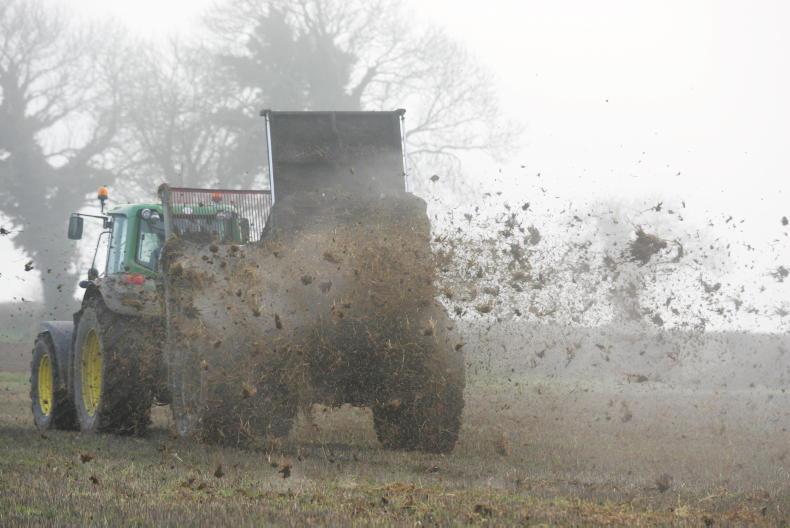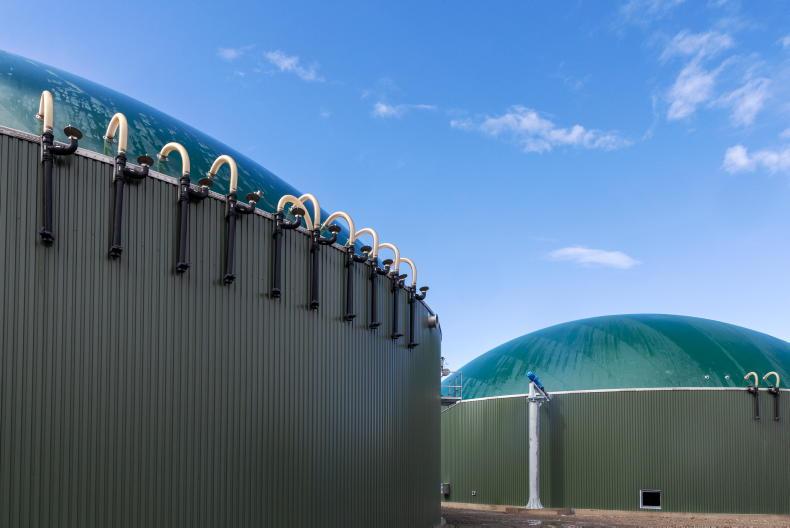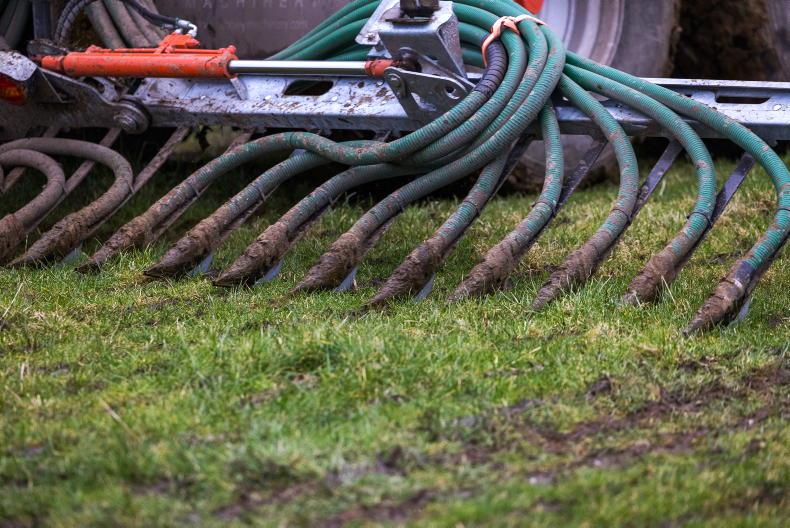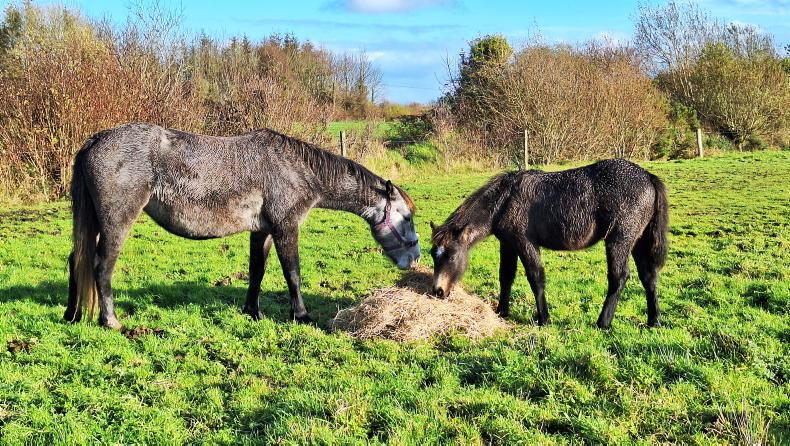From 1 February, farmers are permitted to travel land and apply slurry, provided ground and weather conditions are suitable for the task.
With fertiliser prices still floating between £630 and £750/t at the outset of February for nitrogen and grassland compounds, slurry is a valuable nutrient resource on-farm.
Ideally, to make the best use of slurry, pulling together a quick fertiliser plan for the farm is recommended.
This should take into account soil phosphate (P) and potash (K) levels on a field-by-field basis, as well as the nitrogen requirement to grow arable crops or grass for grazing and silage.
But this is not always practical in early February. On farms with heavier soils, there will be limited fields that can carry a tanker to relieve the pressure on storage tanks filled to capacity.
In such scenarios, is it possible to spread enough slurry to free up enough storage space for the month ahead, then apply the remaining slurry in March when field options increase?
However, assuming conditions are favourable, when it comes to applying slurry in February, outlined are some things to keep in mind.
1 Keep your distance on margins
If spreading slurry in February using a splash plate, it is a legal requirement to keep 15m from any field boundary with a water course. From March on, this margin reduces to 10m.
If using low emission slurry spreading equipment (LESSE), do not spread within 5m of a water course in February reducing to 3m in March.
2 Target low grass covers
Slurry should be targeted to fields with low grass covers, ideally below ankle height. Swards with low covers are unlikely to be grazed until late spring, giving plenty of time for slurry to be washed in.
If heavy covers have accumulated over winter, graze these swards off first with sheep, calves or light weanlings, then apply slurry.
Applying slurry to heavy covers soils, the sward reduces palatability and causes grass to lodge. It takes longer to get into the soil, so there will be nitrogen lost to the atmosphere.
3 Target silage ground
Silage removes a lot of P and K from the soil, so it is important to replenish these nutrients through slurry before topping up with chemical fertiliser as necessary.
Roughly speaking, every 1t DM/ha of grass silage harvested removes around four units/ac of P and 20 units/ac of K, which has to be replaced.
Taking silage at 30% dry matter, this would be the equivalent of growing 8t/ac of grass on a freshweight basis. Slurry is extremely high in potash, so it makes an ideal fertiliser for silage.
4 Spreading rates
Be aware that in February, the maximum slurry application permitted is 2,700 gallons/ac, rising to 4,500 gallons/ac in March.
Soils at index 2 and above should receive lower levels of slurry, as less P and K are required by the crop.
Lower rates can be applied using LESSE kits, as the nutrient availability increases by up to 25% over a splash plates, so slurry reserves can cover a greater acreage.
LESSE must be used on cattle farms with more than 200 livestock units and pig farms producing more than 20,000kg of N annually.
5 Don’t assume all slurry is the same
Slurry will differ in its nutrient value. Animals on high meal levels, such as pigs, dairy cows and intensively finished bulls, will produce a higher value slurry than dry cows and stores on a silage only diet.
On farms with multiple tanks, target the higher value slurries to silage swards and fields with lower P and K status.
Also, keep in mind that soil pH will affect the rate of slurry nutrients available to the crop. Soils at pH 6.3 and above will have 100% nutrient availability.
At pH 5.5, around 77% of nitrogen applied is available for plant growth.
6 Avoid paddocks where cows will graze
As slurry is high in potash, avoid spreading on paddocks where cows in milk will be grazed in early spring.
Potash inhibits magnesium uptake. When combined with changeable weather and lush grass, the risk of tetany will be extremely high.
7 Leave a three to four week
window
If slurry is applied to grassland in early February and there are plans to follow up with a light coat later in spring, make sure to leave a window of at least three to four weeks between dressings.
8 Weather
Slurry spreading is not permitted within 24 hours of heavy rain being forecast.
It cannot be spread on frozen ground either, so pay attention to weather conditions before hooking on the tanker. If possible, spreading slurry on a dull, overcast day is better than a day with clear, blue skies, as there is less atmospheric nitrogen loss.
9 Leave a gap between slurry and fertiliser application
Nitrogen uptake will be low in early spring, so do not overload soils with slurry and chemical fertiliser. Leave a gap of one week if spreading urea or CAN after slurry and vice versa.
10 Safety
Working with slurry has it dangers. When mixing tanks, stay out of sheds and remove animals directly above slurry being agitated.
Never leave mixing points uncovered. Keep children and pets away from mixing points.
Make sure your tractor is fit for purpose, has sufficient weight and power to pull a tanker and most importantly, can brake safely under load. Take care when spreading on sloped ground.
Knowing the value of slurry
As outlined, slurry will vary in its nutrient content depending on the diet fed to the animals that produced it.
Higher fertiliser costs means a 2,000 gallon tank load of slurry is worth a lot of money, but just how much? To put some kind of monetary value on slurry, Table 1 outlines different types of slurry with standard nutrient values.
The NPK content is valued at the current cost of purchasing nitrogen (CAN at £650/t), phosphate (0-46-0 at £750/t) and potash (0-0-60 at £750/t). The figures assume slurry is spread using LESSE in spring to soils at P index 2 with 40% nitrogen availability for cattle slurry, rising to 100% P and K availability.
Note that for cattle, intensively fed animals may produce slurry with more nutrients than stated.
Regardless, the take home message for farmers is that slurry and organic manures provide an excellent source of soil nutrients. Therefore, care should be taken to make the best use as fertiliser.
Read more
Calf rearing: do your budgets before you purchase
Regulator has to be the eyes and ears for farmers
From 1 February, farmers are permitted to travel land and apply slurry, provided ground and weather conditions are suitable for the task.
With fertiliser prices still floating between £630 and £750/t at the outset of February for nitrogen and grassland compounds, slurry is a valuable nutrient resource on-farm.
Ideally, to make the best use of slurry, pulling together a quick fertiliser plan for the farm is recommended.
This should take into account soil phosphate (P) and potash (K) levels on a field-by-field basis, as well as the nitrogen requirement to grow arable crops or grass for grazing and silage.
But this is not always practical in early February. On farms with heavier soils, there will be limited fields that can carry a tanker to relieve the pressure on storage tanks filled to capacity.
In such scenarios, is it possible to spread enough slurry to free up enough storage space for the month ahead, then apply the remaining slurry in March when field options increase?
However, assuming conditions are favourable, when it comes to applying slurry in February, outlined are some things to keep in mind.
1 Keep your distance on margins
If spreading slurry in February using a splash plate, it is a legal requirement to keep 15m from any field boundary with a water course. From March on, this margin reduces to 10m.
If using low emission slurry spreading equipment (LESSE), do not spread within 5m of a water course in February reducing to 3m in March.
2 Target low grass covers
Slurry should be targeted to fields with low grass covers, ideally below ankle height. Swards with low covers are unlikely to be grazed until late spring, giving plenty of time for slurry to be washed in.
If heavy covers have accumulated over winter, graze these swards off first with sheep, calves or light weanlings, then apply slurry.
Applying slurry to heavy covers soils, the sward reduces palatability and causes grass to lodge. It takes longer to get into the soil, so there will be nitrogen lost to the atmosphere.
3 Target silage ground
Silage removes a lot of P and K from the soil, so it is important to replenish these nutrients through slurry before topping up with chemical fertiliser as necessary.
Roughly speaking, every 1t DM/ha of grass silage harvested removes around four units/ac of P and 20 units/ac of K, which has to be replaced.
Taking silage at 30% dry matter, this would be the equivalent of growing 8t/ac of grass on a freshweight basis. Slurry is extremely high in potash, so it makes an ideal fertiliser for silage.
4 Spreading rates
Be aware that in February, the maximum slurry application permitted is 2,700 gallons/ac, rising to 4,500 gallons/ac in March.
Soils at index 2 and above should receive lower levels of slurry, as less P and K are required by the crop.
Lower rates can be applied using LESSE kits, as the nutrient availability increases by up to 25% over a splash plates, so slurry reserves can cover a greater acreage.
LESSE must be used on cattle farms with more than 200 livestock units and pig farms producing more than 20,000kg of N annually.
5 Don’t assume all slurry is the same
Slurry will differ in its nutrient value. Animals on high meal levels, such as pigs, dairy cows and intensively finished bulls, will produce a higher value slurry than dry cows and stores on a silage only diet.
On farms with multiple tanks, target the higher value slurries to silage swards and fields with lower P and K status.
Also, keep in mind that soil pH will affect the rate of slurry nutrients available to the crop. Soils at pH 6.3 and above will have 100% nutrient availability.
At pH 5.5, around 77% of nitrogen applied is available for plant growth.
6 Avoid paddocks where cows will graze
As slurry is high in potash, avoid spreading on paddocks where cows in milk will be grazed in early spring.
Potash inhibits magnesium uptake. When combined with changeable weather and lush grass, the risk of tetany will be extremely high.
7 Leave a three to four week
window
If slurry is applied to grassland in early February and there are plans to follow up with a light coat later in spring, make sure to leave a window of at least three to four weeks between dressings.
8 Weather
Slurry spreading is not permitted within 24 hours of heavy rain being forecast.
It cannot be spread on frozen ground either, so pay attention to weather conditions before hooking on the tanker. If possible, spreading slurry on a dull, overcast day is better than a day with clear, blue skies, as there is less atmospheric nitrogen loss.
9 Leave a gap between slurry and fertiliser application
Nitrogen uptake will be low in early spring, so do not overload soils with slurry and chemical fertiliser. Leave a gap of one week if spreading urea or CAN after slurry and vice versa.
10 Safety
Working with slurry has it dangers. When mixing tanks, stay out of sheds and remove animals directly above slurry being agitated.
Never leave mixing points uncovered. Keep children and pets away from mixing points.
Make sure your tractor is fit for purpose, has sufficient weight and power to pull a tanker and most importantly, can brake safely under load. Take care when spreading on sloped ground.
Knowing the value of slurry
As outlined, slurry will vary in its nutrient content depending on the diet fed to the animals that produced it.
Higher fertiliser costs means a 2,000 gallon tank load of slurry is worth a lot of money, but just how much? To put some kind of monetary value on slurry, Table 1 outlines different types of slurry with standard nutrient values.
The NPK content is valued at the current cost of purchasing nitrogen (CAN at £650/t), phosphate (0-46-0 at £750/t) and potash (0-0-60 at £750/t). The figures assume slurry is spread using LESSE in spring to soils at P index 2 with 40% nitrogen availability for cattle slurry, rising to 100% P and K availability.
Note that for cattle, intensively fed animals may produce slurry with more nutrients than stated.
Regardless, the take home message for farmers is that slurry and organic manures provide an excellent source of soil nutrients. Therefore, care should be taken to make the best use as fertiliser.
Read more
Calf rearing: do your budgets before you purchase
Regulator has to be the eyes and ears for farmers










SHARING OPTIONS